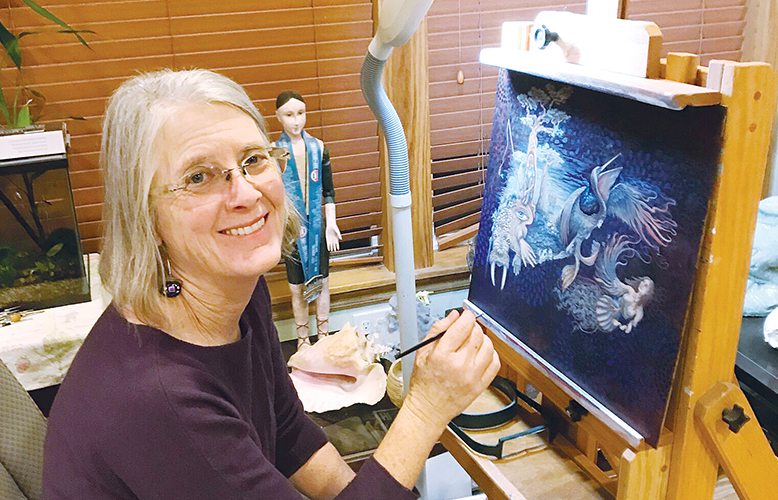Most artists see the world a little differently than the rest of us. With Bend surrealist painter Carol Connett, that’s an understatement of massive proportion. In Carol’s work, a waterfall flows from a tiger’s mouth, a buck sports an evergreen rack (think branches) and a desert-scape body, while a human melds into a tree trunk, a bird, a sea snail or a jellyfish. That’s assuming the person isn’t riding a camel with a TV on their head (Carol’s statement about brainwashing) or a rhino whose horns are on fire.
Carol started conjuring up these alternate realities when she was just eight years old. She would go down to a 20-acre piece of property across from her house, sit with her sandwich and let her imagination run wild. “I would sense what it would be like to have multiple arms. I would pick up a rock and feel it with the hand belonging to the arm that didn’t exist,” she recalls. “I would think I had wings and flap them. I would look at trees and see them as body parts with branches stuck on them.”
Decades later, she still enjoys creating potential realities. “Working from my own personal mythology, I create worlds, morphing creatures and the rules of nature,” she says. “Cooperation between species is a reoccurring theme; no animal or spirit is forced to work with humans in my art. There’s no subservience. Rather, there’s an equality. They cooperate as friends.
“My paintings are also deeply personal. These landscapes are my home—I am always in there somewhere. Although some of my work incorporates the intense challenges humanity and the natural world face these days, it’s always my goal to view the world from a positive vantage point. The world is amazing and wonderful and, yes, we can make a difference. I’ll also include a nod to technology that adds a little comedy to the commentary.”
Carol, whose work has been featured in several Los Angeles gallery shows over the last few years, mostly paints in acrylic and occasionally oil, and has started to incorporate fiber into her pieces, creating paintings on canvas and sewing them into quilted wall hangings. When a well-formed idea for a painting shows up—often when she’s in spin class—she’ll lose track of what she’s supposed to be doing. “It’s like some kind of daydream on steroids,” she says. In contrast, vague ideas result in her drawing “piles of junk to the point that I’m surrounded by crumpled paper on the floor” until, days later, she finally gets what she wants. The next day she decides if it’s garbage, almost there or perfect. Even in the latter case, she’ll go back and try to do a better job. “I don’t settle,” she says. “I make sure it’s the best thing I can possibly draw, because that’s the blueprint. If I don’t get the drawing right, which is the hardest part, the painting won’t work.”

